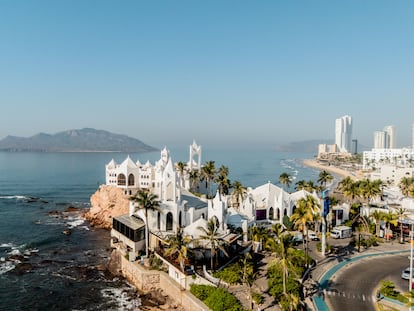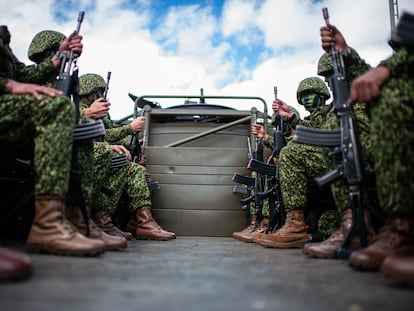Ioan Grillo: ‘American kids are being killed with assault rifles and they don’t change the law, so what do they care about Mexico?’
The English author’s book ‘Blood Gun Money’ is a call for ‘common sense’ and a denunciation of the U.S. paradox that sees a migrant as being more dangerous than a machine gun

These are strange times for the Americas, particularly for Mexico, the connecting point of the Latin and English-speaking worlds, the favorite punching bag of that great world power, the United States, which sees in its southerly neighbor the root of all its evils. Tariff threats and the whiff of military intervention currently characterize this bilateral relationship, which is constructed on the Manichean concept of a problematic South as an inexhaustible source of drugs and migrants, the great nightmare of the all-powerful Republican Party. Mexico defends itself as best it can, with restraint, trying to draw attention to the flip side of the coin: the conflicts that flow from the north and that are of little interest to Washington.
The foundational paradox: Donald Trump’s America demands that Mexico resolve the two countries’ shared problems — drugs, migrants — without once stopping to think about its own responsibility in the matter. This is where the work of Ioan Grillo enters the scene. A journalist, writer and globetrotter who has spent the last 24 years documenting the North American dynamics of crime, drug trafficking, violence, the logic, inertia and conflicts of criminal groups in this new century — in short, the underbelly of a massive and vaporous economy that knows no borders and is interested exclusively in market and profit.
Grillo, born in England in 1973, is spending a few days in his hometown near the coastal city of Brighton while he promotes the Spanish translation of one of the three books he has dedicated to the subject: Blood Gun Money: How America Arms Gangs and Cartels, which is set to be published by the Spanish editorial Trillas. The author spoke with EL PAÍS by videocall, just a few days after the U.S. Supreme Court rejected the Mexican government’s lawsuit against a handful of gun manufacturers over their supposed responsibility for the wave of violence Mexico is experiencing. “I don’t think it is a failure,” he says, “because it has put the subject on the table again.”
Question. This morning, I was remembering the Fast and Furious operation, through which U.S. authorities allowed arms shipments to Mexico, supposedly to track down trafficking networks. It was a disaster, but it only became a scandal when one of the weapons was used in the murder of a Border Patrol agent in 2011. Is there any hope of the United States understanding that part of the binational crisis is its own fault?
Answer. I’ve always thought about that. I have been working in Mexico and the United States for 25 years. Since 2004 and 2005, I’ve been looking at the subject of arms, of trafficking. And I think, what can we do? And look … even with the massacre at the elementary school in Connecticut in 2012 [in which 20 children were murdered at the Sandy Hook Elementary School], they didn’t want to review the law… American kids are being killed with assault rifles and they don’t change the law, so what do they care about Mexico?
Then I interviewed a Ciudad Juárez arms trafficker, who did a good job of explaining to me how trafficking functions. That was when I realized that they’re almost giving away these weapons to the cartels, as if they were low-hanging fruit to pick from a tree for them.
The truth is that now, U.S. authorities have more tools with which to act. There are two new laws that could work against trafficking. One is the federal anti-arms trafficking law of 2022 and the other is the Trump administration’s designation of cartels as terrorist organizations. Are they going to use them? I don’t know, but it wouldn’t be very hard… even a few cases could have an enormous impact. Punishments have been greatly increased, up to life sentences, if there are deaths [resulting from shots fired by the trafficked arms]. Mexico has room to apply pressure there.
Question. In 2022, 15 million weapons were sold in the United States. Arizona and Texas were the origin points for the majority of them, specifically 10 towns and counties. Why doesn’t the United States tighten control in those places?
Answer. The agency that takes care of those things is the Bureau of Alcohol, Tobacco, Firearms and Explosives (ATF). Historically, that agency has dedicated relatively few agents to this. At the end of the day in the United States, weapons are a legal industry. The place with the highest trafficking is Phoenix, Arizona, but the ATF only has 20 agents there, for thousands of stores. To give you an idea, in the United States there are five times more gun stores than there are McDonald’s restaurants.
The cartels use four methods to get arms, the most common one is using straw buyers [people with U.S. citizenship who can buy as many weapons as they want without any problem]. When they are caught, a lot of the time they don’t face any punishment. For example, look at the case of the ICE agent Jaime Zapata, who was murdered in Mexico in 2011 with a weapon that came from the United States. That straw buyer didn’t even go to jail. They gave him probation. It’s not a subject of interest, because there are no sentences for those responsible. Now, that could change, because of the designation of cartels as terrorist organizations.
They call the second method “private sale loophole,” a legal gap that allows for the sale of arms between individuals. When a person buys a gun in the United States, they have to show identification and pass a background check, but there are exceptions, like sales between individuals. And in the gun fairs that’s what happens, they sell new AR-15s under the excuse that they are collector’s items. One solution would be to close that loophole of private sales. But millions of arms are being sold like that, and it also has the support of the National Rifle Association. They defend it, because they’re against any kind of gun reform.
Question. The AR-15 has been a symbol of the massive trafficking from the United States to Mexico for the last 21 years, following the end of restriction on the sales of automatic weapons in the United States. Is there any way to address this, or go back to the way things were before?
Answer. That restriction ended in 2004. And in Mexico, there was in increase in conflicts with narcos, violence, even before the Felipe Calderón administration (2006-2012). During that time, ejecutómetros [tallies of deaths related to organized crime] began to emerge… Surely, the end of that restriction was a factor that contributed. But it isn’t the only one, it’s a process that also has to do with political change, shifting cocaine routes, which switched from the Florida connection to the land-based routes through Mexico…
If you look at the 1980s and ‘70s in the United States, the AR-15 was not that common. People had hunting rifles, pistols. But when the restriction ended, they began to manufacture them. [Former president Barack] Obama comes and says, ‘Hey I’m going to put a restriction on this, people are buying so many of them.’ I think it would be tough for them to ban assault weapon sales again. Trump isn’t going to do it.
Question. It’s estimated that every year, 200,000 arms are trafficked from the United States to Mexico. Are borders just for migrants and drugs?
Answer. The figure I use the most is the following: from 2007 to 2023, 227,000 arms decommissioned in Mexico were traced back to U.S. manufacturers. That is a fact, hard data. Mexico and the media should apply more pressure there. Mexico’s lawsuit against arms manufacturers was effective, even though it failed after four years. But it managed to put the subject in the media, in the debate. They should keep insisting.
Question. You have mentioned the story of Jorge, who left a construction job that paid 6,000 pesos ($314 USD) a month to earn $10,000 per arms trip. How did you find him?
Answer. I was researching the subject of arms trafficking. I went to Juárez and got into contact with the director of the state prison and asked about the issue. He told me that he had a prisoner who was serving time for that crime. It was Jorge. He gave us access for an interview and he turned out to be very open, he told me his whole story with all the details. On that same trip, we went to a gun fair in Mesquite, Texas and filmed there undercover. And then I went to Romania, where they manufacture AK-47s, to learn about the history of the factory.
Question. What is that gun fair like?
Answer. It’s a town that has a lot of gun fairs. And at the fair, there are hundreds of stands. There are all kinds of weapons, AK-47, AR-15, antiques, new guns, a huge quantity of arms. And there are a lot of people, arms enthusiasts, because there’s an impressive subculture there, people who love them, who use them for sport, as a symbol of liberty… Later, I went to one that was even bigger, in Las Vegas, called Shot Show, which isn’t open to the public, it’s just for wholesalers. That fair is very close to the place where a man fatally shot more than 50 people at music festival in 2017.
Sign up for our weekly newsletter to get more English-language news coverage from EL PAÍS USA Edition
Tu suscripción se está usando en otro dispositivo
¿Quieres añadir otro usuario a tu suscripción?
Si continúas leyendo en este dispositivo, no se podrá leer en el otro.
FlechaTu suscripción se está usando en otro dispositivo y solo puedes acceder a EL PAÍS desde un dispositivo a la vez.
Si quieres compartir tu cuenta, cambia tu suscripción a la modalidad Premium, así podrás añadir otro usuario. Cada uno accederá con su propia cuenta de email, lo que os permitirá personalizar vuestra experiencia en EL PAÍS.
¿Tienes una suscripción de empresa? Accede aquí para contratar más cuentas.
En el caso de no saber quién está usando tu cuenta, te recomendamos cambiar tu contraseña aquí.
Si decides continuar compartiendo tu cuenta, este mensaje se mostrará en tu dispositivo y en el de la otra persona que está usando tu cuenta de forma indefinida, afectando a tu experiencia de lectura. Puedes consultar aquí los términos y condiciones de la suscripción digital.
More information
Archived In
Últimas noticias
Welcome to the post-religion era: The idea of Christianity as the absolute truth has become obsolete
‘I thought you would like it’: The risky sexual practice popularized by TV shows and TikTok
The digitalization of tourism: ‘They promise experiences and gave us the worst possible one’
Mexican peso defies uncertainty with forecasts of a new period of stability in 2026
Most viewed
- Sinaloa Cartel war is taking its toll on Los Chapitos
- Oona Chaplin: ‘I told James Cameron that I was living in a treehouse and starting a permaculture project with a friend’
- Reinhard Genzel, Nobel laureate in physics: ‘One-minute videos will never give you the truth’
- Why the price of coffee has skyrocketed: from Brazilian plantations to specialty coffee houses
- Silver prices are going crazy: This is what’s fueling the rally











































